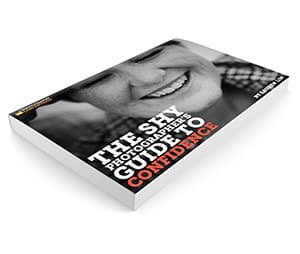How to Pose Grooms and Groomsmen Effectively
Wedding days aren’t just about the bride, even though it might seem that way. As photographers we must also take photos of the groom by himself and with his groomsman buddies – whether they like it or not.

Posing the groom alone
When posing the groom alone you often see stiffness and shifting eyes because most men don’t feel comfortable having their photo taken. So it’s worth starting a conversation that has nothing to do with the wedding to relax them and settle their nerves.

Find a nice background where you can photograph the groom at three different crops: full-body, half-body, and close-up. These three crops will add variety to your portraits, and give you more options when choosing the best portrait to deliver to your clients.

For example, window lighting can add dimension and depth while the groom is adjusting his tie or watch, or buttoning his shirt. Have the groom look out the window, or at his watch or tie. This keeps his hands busy, and because he’s not looking at the camera he won’t feel as vulnerable.

When you’re outside you can have the groom lean on a wall, or simply stand in the middle of a walkway. To help him pose naturally, tell him to stand as if he was by himself and not getting his photo taken.
Also, remind him to breathe. The stiffness is often caused by the groom holding his breath. It will also help him relax his shoulders and overall stance.

Photographing the groom at three different crops is a great way to add variety to the final images.
If the groom usually puts his hand in a pocket, have him put the one furthest from the camera into his pocket. This can help make the portrait feel more natural. Having the groom look at various points beyond the camera (to the side, behind you, or even at his shoes) can reduce the nerves and stiffness, and make him feel more comfortable.

As you’re taking the groom’s portraits, feel free to joke around, talk about things they like, or simply compliment them. This can make them feel more comfortable and bring about natural smiling and laughing, as well as fill in the silence.

Sitting is another great way to pose the groom. Have him sit on steps, a short wall or a chair. It will make the groom feel less stiff, and allow you to focus on various details of his outfit such as his shoes or socks if he chose something special.

Portraits of the groom while with the bride
But the groom doesn’t have to be completely alone in his portraits. A beautiful portrait of the groom with his bride can isolate him while placing him in the overall story of the wedding day.

Pose the couple facing each other, and ask the bride to place her head on his chest or arm to bring her face out a little. Then have her close her eyes while you direct the groom to look at the camera.
Another great portrait is having the groom at a 45-degree angle, with the bride behind him. Ask her to put her head on his back/shoulders, and have him look either directly at you or off into the distance.

He doesn’t have to smile. He can even look a little more serious. But the big picture will still look romantic and show that the couple is sharing a special moment.
You can move the groom and bride from there and create variations where the groom is:
- in focus
- in the forefront
- looking directly at the camera
- the main focal point in the photo.
These will all make great portraits of the groom and help him pose with his bride.
Groomsmen
Groomsmen are really fun to photograph. Most of the time they’re buddies and will joke around a bit, which can make for great candid photos. But it can also mean they won’t take the photo shoot seriously.
One way to get them to listen and cooperate is to let them know the faster they get through the photo shoot, the sooner they can start having fun. But don’t use this trick until you’ve captured some candids showing how they all interact, as it will be nice for the groom to have those as well.

Keep at least three different groomsmen setups in mind before photographing the wedding. You can find inspiration online and save those inspirational photos on your phone to recreate or build on them. This can save you lots of time if you’re new to wedding photography.
Try and keep the conversation light and easygoing. It will help the groomsmen relax, and you’ll get much more authentic expressions from them.


Group huddles and hugs are great icebreakers, and can lighten the mood if you feel the photos are getting a little stiff or the groomsmen are losing steam. A slow walking photo is also nice to have and having them looking at each other and talking is a great way to get them all smiling.

A staggered photo, either on a staircase or in a big area, can provide you with more varied poses for your final photos. If you have enough time, get a photo of each groomsman with the groom. Keep the photos moving by keeping the groom in the same place and having the groomsmen take turns standing beside him.

Keep everyone’s height variations in mind when taking photos of the groom with his groomsmen. Taller groomsmen may need to stand further back. If there are big height differences between the groom and his groomsmen, place those who are about the same height next to the groom, or bring the groom closer to the camera. This can help isolate the groom and make him the focal point of the photo, which is exactly what you want.

Keep everyone moving and try to get the photos done quickly. Groomsmen are usually ready for the next event pretty quickly and get sick of the camera much faster than the bride and bridesmaids.
If the groomsmen have ideas for poses, go along with them. It may be an inside joke or something that brings them closer together as buddies. And they’re usually the photos they love to remember.

Also, always ask if the groomsmen are wearing something special or have a gift from the couple – watches, socks, matching shoes, flasks, etc. These items have far more meaning when they’re photographed in the hands of those who received or are wearing them.

For example, these groomsmen all received personalized flasks from the groom, so a toasting photo was fun to create for them, along with a close-up of one of the flasks.

Grooms and groomsmen are fun to photograph during a wedding. But it’s best to have a few poses in mind so you can work quickly, as they often don’t like having their photos taken and may tire quickly. Keeping the mood light and fun gives them a great experience, and they’ll look back at the photos with fond memories.








